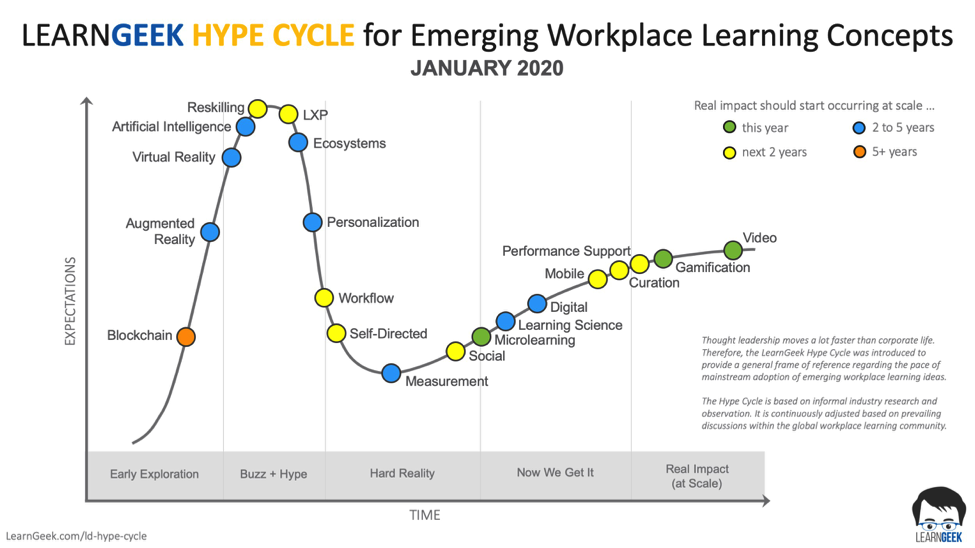My column from one year ago was titled “Learning Will Not Change in 2019.” I reflected on how much faster “thought leadership” tends to move as compared to corporate reality. Therefore, despite all of the buzz and hype around new ideas, most organizations would not be taking gigantic leaps forward over the next 12 months. Specifically…
While most L&D teams will be stuck in a pseudo status quo, a small group will take meaningful steps forward towards delivering real, quantifiable value to their organizations. But this group won’t base their changes on L&D trends. Rather, they’re paying attention to the real changes taking place around them, and proactively adjusting their practices. They’ll take advantage of both new and established L&D tactics and technologies, but only when they are the right fit based on the evolving needs of their workplaces.
Now, 12 months later, I feel pretty confident in saying that I was right. Honestly, how different is the industry in real life today as compared to January 2019? Some conversations have progressed, but the everyday realities of corporate learning are pretty much the same. Compliance is a nagging challenge. Onboarding needs to be redesigned. Technology is confusing. Measurement is broken.
Nevertheless, “thought leadership” continues. Every new concept, insight, and platform is marketed as “the solution we have always been looking for” as opposed to what they (sometimes) are—interesting ideas that may help L&D take a meaningful step forward. But what’s the reality behind the buzz? How are the most-discussed topics in workplace learning actually impacting the profession? How do these different topics fit together to shape a larger L&D vision?
As a way to try and wrap my head around these questions, I created the LearnGeek Hype Cycle. (Figure 1)

Figure 1: The latest edition of the LearnGeek Hype Cycle
I review the 20 biggest emerging L&D topics of the moment and place them onto a curve inspired by the Gartner Hype Cycle. Each section of the curve falls into one of five states of evolution:
? Early Exploration: We’re still trying to figure out if/how this topic fits within workplace learning
? Buzz + Hype: This topic is everywhere, I can’t get away from it, and everyone is telling me that it's the answer I need
? Hard Reality: The buzz is fading, now we have to figure out how to get actual value from this topic
? Now We Get It: The hype is over, now all that remains are proven practices
? Real Impact (at Scale): It’s working, it’s finally working
Placement isn’t meant to be rigorous and scientific. Rather, it’s based on practical observation—a blend of industry insight (articles, research papers, conference sessions, books, etc.) and everyday reality (conversations and experiences with L&D pros on the frontlines). Topics move at their own paces and may sometimes slide backwards. I update the details every three months to provide a snapshot of overarching industry progress. The latest version of the Hype Cycle along with a more detailed breakdown is available on LearnGeek.
Here’s a quick summary of where I find the 20 most-hyped topics as we begin 2020.
Early Exploration
The conversation around blockchain and distributed ledgers is still just getting started and doesn’t have any real definition. While augmented reality (AR) is further along and some performance support-related use cases are in motion, the tech is in very early stages, especially given how limited consumer applications is to date.
Buzz + Hype
The virtual reality (VR) hype is building, but the tech is still complicated and use cases are limited. Artificial intelligence (AI) application is expanding, but the L&D conversation remains limited around basic use cases, such as content tagging and recommendation. Reskilling is quickly becoming the next microlearning, as organizations struggle to help employees keep pace with the changing workplace. Learning experience platforms are everywhere, but their limited capabilities are being integrated into other learning technologies so quickly that it may eliminate the need for an LXP category. The term “ecosystem” is widely used to explain the holistic concept of workplace learning, but how the pieces fit together remains a big question. Finally, personalization is about to escape the hype and become a more tactical discussion, especially when connected to other topics like AI and reskilling.
Hard Reality
Workflow learning, learning in the flow of work, whatever you want to call it… was the biggest buzz term of 2019. Now, organizations are trying to figure out how to bring the concept to life. These organizations are also realizing that a strategy built around providing large, aggregated, self-directed content libraries in an LXP is not a sufficient way to address short- or long-term employee development. Impact and ROI are constantly in the headlines, but L&D remains anchored to antiquated, ineffective measurement models. Lastly, social learning discussion is not focused solely on technology for the first time in a decade, but most teams still haven’t figured out how to apply the concept to support performance.
Now We Get It
We’re almost… almost… over microlearning. The term will fade but the principles should become the foundation of modern workplace learning strategy. Learning science concepts, such as reinforcement, attention and reflection, are heavily-discussed. However, many L&D teams continue to rely on one-and-done courses and therefore have limited applications in place. Digital learning now means more than online courses. Mobile devices are used more than ever—especially outside North America—and are not just another way to deliver eLearning. Curation isn’t discussed as much as it was 2+ years ago, but it’s still regarded as a critical foundational capability for a modern L&D team.
Real Impact (at Scale)
Performance support is now a persistent focus for most L&D teams, even if the tactics are still in the works. Today, we talk more about user motivation, engagement recognition and immersions than we do about “gamification.” While the pendulum has swung a bit hard towards “everything should be video,” this is just another tactic in the L&D toolbox and almost doesn’t fit the “emerging workplace learning topic” criteria anymore.
I’ll end this column in the same way I did last year’s January edition …
Rather than starting with L&D “thought leadership,” look inside your own organization to determine how you must evolve your strategy to help your organization meet its (current) goals. Then, apply only right-fit solutions—regardless of how they relate to the latest trends. That’s how you stay relevant and build your value as a critical part of your company’s success, regardless of the time of year.
What do you think of the latest LearnGeek Hype Cycle? Would you have included any other topics? How would you position them based on what you see happening within the L&D profession?



